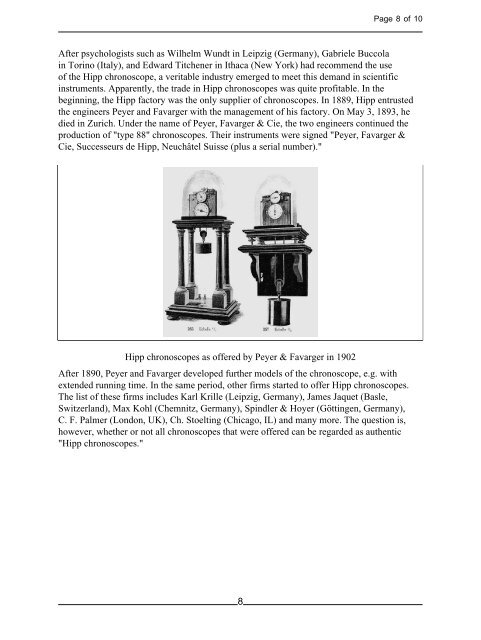The Hipp Chronoscope.
The Hipp Chronoscope.
The Hipp Chronoscope.
You also want an ePaper? Increase the reach of your titles
YUMPU automatically turns print PDFs into web optimized ePapers that Google loves.
Page 8 of 10<br />
After psychologists such as Wilhelm Wundt in Leipzig (Germany), Gabriele Buccola<br />
in Torino (Italy), and Edward Titchener in Ithaca (New York) had recommend the use<br />
of the <strong>Hipp</strong> chronoscope, a veritable industry emerged to meet this demand in scientific<br />
instruments. Apparently, the trade in <strong>Hipp</strong> chronoscopes was quite profitable. In the<br />
beginning, the <strong>Hipp</strong> factory was the only supplier of chronoscopes. In 1889, <strong>Hipp</strong> entrusted<br />
the engineers Peyer and Favarger with the management of his factory. On May 3, 1893, he<br />
died in Zurich. Under the name of Peyer, Favarger & Cie, the two engineers continued the<br />
production of "type 88" chronoscopes. <strong>The</strong>ir instruments were signed "Peyer, Favarger &<br />
Cie, Successeurs de <strong>Hipp</strong>, Neuchâtel Suisse (plus a serial number)."<br />
<strong>Hipp</strong> chronoscopes as offered by Peyer & Favarger in 1902<br />
After 1890, Peyer and Favarger developed further models of the chronoscope, e.g. with<br />
extended running time. In the same period, other firms started to offer <strong>Hipp</strong> chronoscopes.<br />
<strong>The</strong> list of these firms includes Karl Krille (Leipzig, Germany), James Jaquet (Basle,<br />
Switzerland), Max Kohl (Chemnitz, Germany), Spindler & Hoyer (Göttingen, Germany),<br />
C. F. Palmer (London, UK), Ch. Stoelting (Chicago, IL) and many more. <strong>The</strong> question is,<br />
however, whether or not all chronoscopes that were offered can be regarded as authentic<br />
"<strong>Hipp</strong> chronoscopes."<br />
8
















